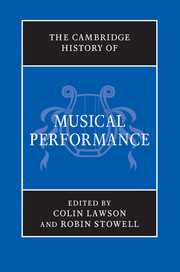Book contents
- Frontmatter
- PART I PERFORMANCE THROUGH HISTORY
- PART II PRE-RENAISSANCE PERFORMANCE
- PART III PERFORMANCE IN THE RENAISSANCE (C. 1430–1600)
- PART IV PERFORMANCE IN THE SEVENTEENTH CENTURY
- 16 Performance in the seventeenth century: an overview
- 17 Vocal performance in the seventeenth century
- 18 Instrumental performance in the seventeenth century
- 19 Case study: Monteverdi, Vespers (1610)
- PART V PERFORMANCE IN THE ‘LONG EIGHTEENTH CENTURY’
- PART VI PERFORMANCE IN THE NINETEENTH CENTURY
- PART VII THE TWENTIETH CENTURY AND BEYOND
- PART VIII
- Index
16 - Performance in the seventeenth century: an overview
from PART IV - PERFORMANCE IN THE SEVENTEENTH CENTURY
Published online by Cambridge University Press: 28 March 2012
- Frontmatter
- PART I PERFORMANCE THROUGH HISTORY
- PART II PRE-RENAISSANCE PERFORMANCE
- PART III PERFORMANCE IN THE RENAISSANCE (C. 1430–1600)
- PART IV PERFORMANCE IN THE SEVENTEENTH CENTURY
- 16 Performance in the seventeenth century: an overview
- 17 Vocal performance in the seventeenth century
- 18 Instrumental performance in the seventeenth century
- 19 Case study: Monteverdi, Vespers (1610)
- PART V PERFORMANCE IN THE ‘LONG EIGHTEENTH CENTURY’
- PART VI PERFORMANCE IN THE NINETEENTH CENTURY
- PART VII THE TWENTIETH CENTURY AND BEYOND
- PART VIII
- Index
Summary
Music of the Baroque era has occupied a special place in the drive towards ‘authentic’, ‘period’ or (so current parlance prefers) ‘historically informed’ performance. HIP is, of course, hip, and has been for a long while; it is also a source of some anxiety, and not just from a more conservative cast of performers anxious to preserve their own hard-earned traditions. While HIP might in principle extend across all repertoires, its central tenets are usually deemed less relevant to music somehow closer to our own time. Therefore, if perhaps the greatest composer of the late sixteenth and early seventeenth centuries, Claudio Monteverdi (1567–1643), was the ‘creator of modern music’, so Leo Schrade famously styled him in 1950, then his operas, sacred music and madrigals might not need the benefit – or the crutch – of HIP to convey their messages. Likewise, if Bach and Handel mark the start of the so-called ‘common practice’ period deemed essential to the music-theoretical training of any musician, then their music presumably speaks to all times independent of how authentic its performance. Nor is this ‘presentist’ (universalist, transcendentalist) stance annulled by the ‘historicist’ arguments often adduced in favour of HIP: that period performance brings the music somehow back to what the composer intended (which succumbs to the intentional fallacy), or to how it might have been heard in its time (but we are not authentic listeners). Further, advocates of HIP can easily be accused of opportunism (for commercial gain), escapism (from the dreaded musical avant-garde) or even just the exotic Ye-Olde-Tea-Shoppe fakery of the heritage industry. But although postmodernism has thrown a spanner in the works – so my previous remarks suggest – the battle for HIP has been fought and rightly won in many musical environments. Moreover, few can deny that its best exponents have the virtue of making old music sound fresh, vital and even new. While this might seem a convenient paradox, it is a laudable enough aim for any repertoire.
- Type
- Chapter
- Information
- The Cambridge History of Musical Performance , pp. 375 - 397Publisher: Cambridge University PressPrint publication year: 2012

